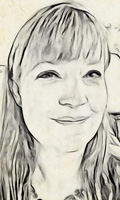
Dr. Amy Gooch - Research Computer Scientist
Working Off Campusphone (801) 828-5038
Background
Dr. Amy Ashurst Gooch is an assistant professor at the University of Victoria in British Columbia, Canada. Amy earned her BS in Computer Engineering and MS in Computer Science from the University of Utah. Amy earned her PhD in Computer Science June 2006 at Northwestern University, where she was also a researcher and instructor. While working on her Masters degree in Computer Science, she explored interactive non-photorealistic technical illustration as a new rendering paradigm and presented part of this work at SIGGRAPH 1998 and at the SIGGRAPH 1999 course on Non-Photorealistic Rendering. She has also co-authored the first book in the field, "Non-Photorealistic Rendering", published by AK Peters, 2001. For five years as a research scientist at the University of Utah, her research focused on increasing the effectiveness of computer graphics in conveying information about the three-dimensional world. Her current research is part of an interdisciplinary effort involving computer graphics, games, perceptual psychology, and computational vision. She is interested in better understanding the spatial information potentially available in CG imagery, determining what cues are actually used when CG imagery is viewed, and using this information to create improved rendering algorithms and visualizations.Research Interests
- Computer graphics
- Image processing
- Human perception
- Non-photorealistic rendering
- Computational aesthetics
- Computational photography
